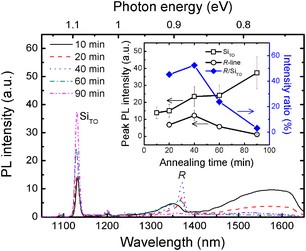Article contents
Direct correlation of R-line luminescence with rod-like defect evolution in ion-implanted and annealed silicon
Published online by Cambridge University Press: 08 August 2012
Abstract

A quantitative correlation between R-line luminescence at around 1.37 µm and {311} defect nature, size and concentration has been undertaken in silicon, following keV Si-implantation and subsequent annealing using photoluminescence spectroscopy and plan-view transmission electron microscopy. The formation and evolution of the rod-like defects were found to be dependent on annealing time at a temperature of 700 °C, but there was no simple correlation found between the density and size of those defects and the R-line intensity. In particular, whereas the presence of {311} defects is essential for observing R-line luminescence, both very small {311} defects at short annealing times and fully developed {311} defects at long annealing times do not contribute to such luminescence. We provide possible explanations for this behavior and suggest that the local (strain) environment around defects, the dopant level and impurities in the silicon substrate may all play a role in determining R-line intensity.
- Type
- Research Letters
- Information
- Copyright
- Copyright © Materials Research Society 2012
References
- 2
- Cited by




